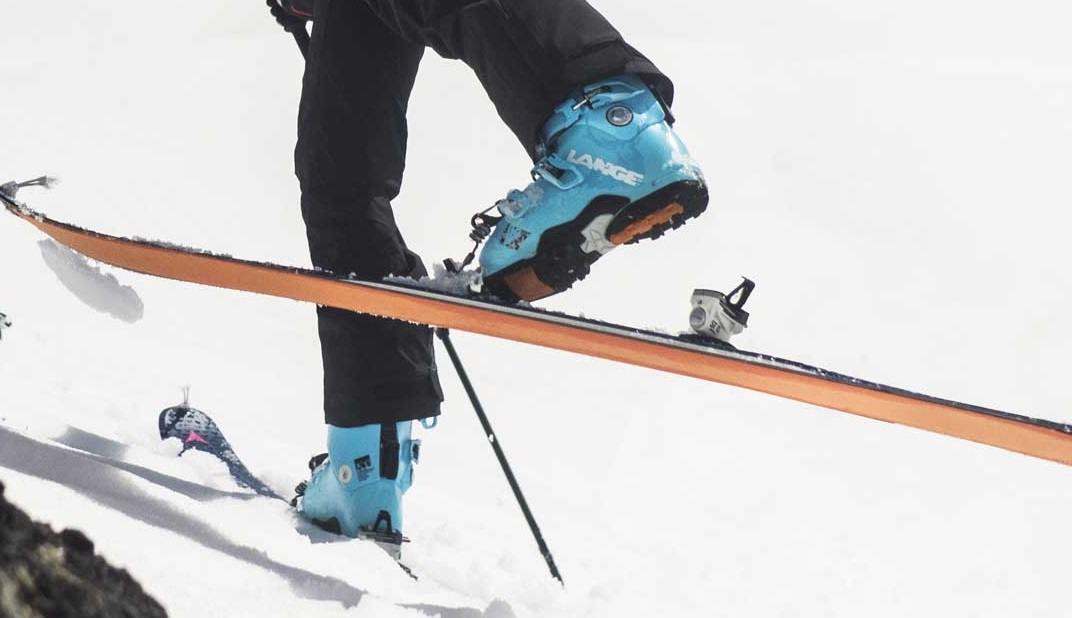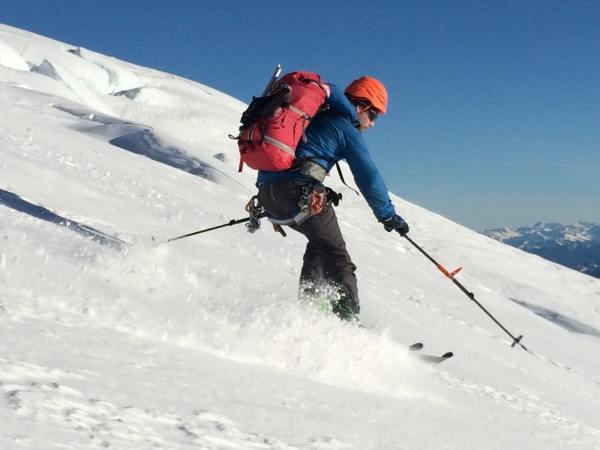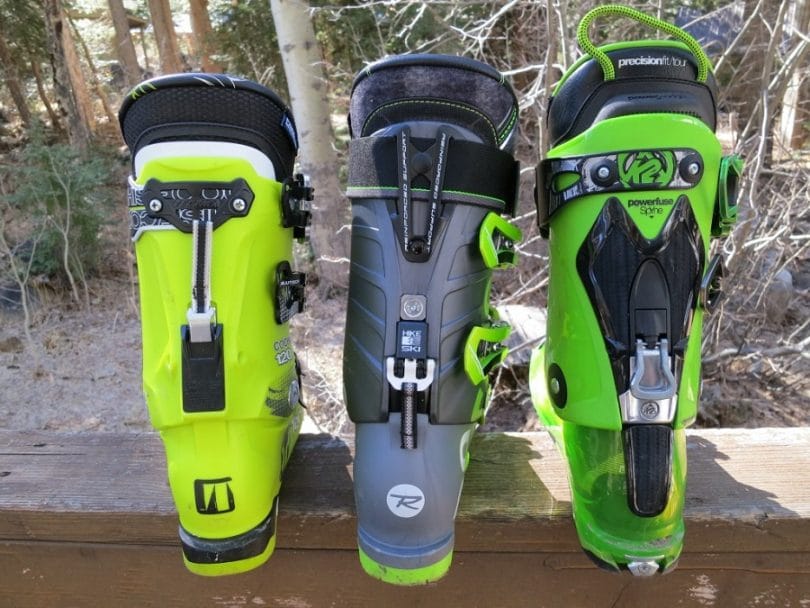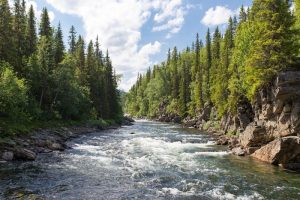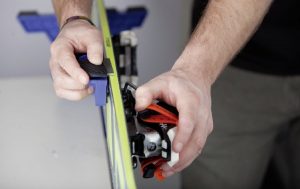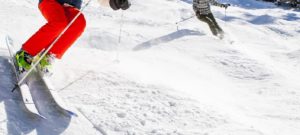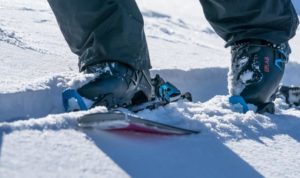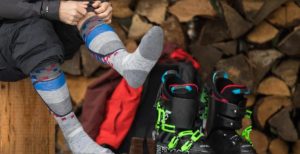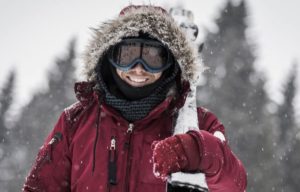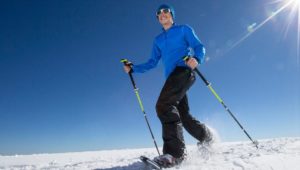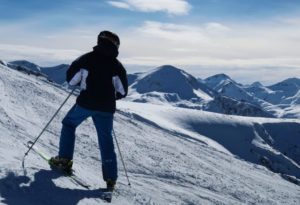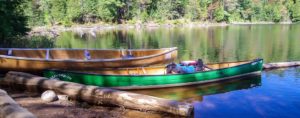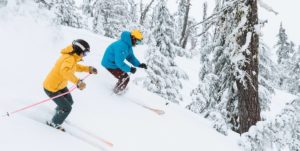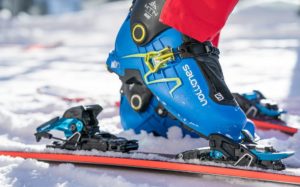Looking for the best men’s all-mountain ski boot? We compared six of the top alpine boots and tested them extensively to find out which one is right for you. We tested them side-by-side, run for run, and for days on end while on ski patrol. We skied in a variety of conditions, on all types of terrain and on several different skis. California’s beautiful Sierra Nevada mountain range provided the perfect test hill at Mammoth Mountain and Kirkwood Ski Resort. These boots were put through the wringer to determine how they measured and compared in downhill performance, comfort and fit, features, durability, and warmth.
Best Overall Men’s Ski Boots: Lange RX 120
- Excellent medium volume fit
- Comfortable liner
- Great buckle adjustments
- Downhill performance
- Thin tongue on liner
- Soft rubber soles wear easily
Lange was the pioneer of plastic alpine ski boots in the early 1960’s and they have been a leader in the industry ever since. They continue to produce quality boots today. The Lange RX 120 is a familiar looking boot: it has a very traditional overlapping 4 buckle design that is widely used by the company and the ski industry as a whole. We like its simple design, useful features, and consistent flex. With a responsive, close fit, it scored the highest out of all of the boots we tested in downhill performance.This boot handles skiing groomed terrain with speed and bounces through both off-piste terrain and steep technical terrain with ease. The 100 mm last makes it an approachable fit for average feet and the RX is available in 3 different flex ratings, 100, 120, and 130, making the design available to skiers of different tastes, sizes, and abilities.
Best Bang for the Buck: Rossignol Alltrack 120
The Rossignol All Track 120 is an affordable boot that is an excellent choice for upper-intermediate skiers looking for a performance oriented boot. We think this is an ideal choice for someone who skis up to twenty days a year and doesn’t want to shell out tons of money on his equipment. This is a comfortable boot thanks to its relaxed 102 mm last width, and it scored well in the warmth comparison. Although a backcountry/ski touring boot is a better choice, we like the addition of the walk mode to this boot and its relatively lightweight. The Rossignol All Track Series is available in 100 mm last widths and 90-130 flex options.
Top Pick for Sidecountry Versatility: Tecnica Cochise 120
- Great mobility in walk mode
- Replaceable soles (interchangeable w/alpine touring bindings)
- Great liners
- Lightweight materials
The Tecnica Cochise 120 is a fine example of a modern freeride/adventure ski boot. This boot was updated for 2018 introducing different fit characteristics and an all-new color scheme. Its stable platform, highly adjustable buckles, and traditional overlap shell/cuff design make it a strong performer inside the resort boundary, while it’s lightweight materials, available alpine touring soles, and high-quality walk mode make it a likely candidate to take you outside of the ski area and on short tours. This boot is comfortable without feeling boxy, and is exceptionally warm on long chair lift rides. The heat moldable liner and ease of entry scored extra points for comfort in this performance boot. The Cochise line of boots from Tecnica use a plastic material blend that is lightweight but still stiff enough for pounding laps in-bounds all day. The Cochise is available in 4 different flex ratings; 90, 110, 120, and 130. A good choice for in-bounds skiers who want a slight backcountry bias.
Choosing the best Ski Boots for You
Your ski boots are quite possibly the single most important piece of equipment to consider when hitting the slopes. They transfer your body’s energy to the ski and then to the snow. Good boot fit improves ski performance and comfort for full days at the mountain.
Every dedicated and experienced skier has a valuable opinion about which boot is the best, and has an even more valuable opinion about which boots are not. Be cautioned, the boot that works best for the racers you see flying down a course, the ski patrollers working all day in their boots, and your friend, may not be the best boot for you.
Refer to our Buying Advice article to learn more about specific design features of an all-mountain alpine boot and how to find the right boot for your foot. Check out How We Test to find out how we tested and compared the models we evaluated.
After you choose the best fitting boots, check out our detailed review of all-mountain skis to complete your kit for the mountain.
Be sure to check out our Buying Advice to help you begin your quest for the perfect boot. For the ladies, read The Best Ski Boots for Women Review to learn more about why buying a women’s specific boot is important.
Types of Ski Boots
All the boos reviewed here are all mountain ski boots. If you are a dedicated backcountry skier there are boots for you too! The adventure/freeride boots reviewed here are probably a bit much for tours that demand lightweight gear. Backcountry boots sacrifice some downhill performance in order to climb better and weigh less. They tend to use very lightweight materials and have a walk mode that allows for excellent range of motion and hiking efficiency.
Anatomy of a Ski Boot
Shell
The shell is the hard plastic outer boot, which is the primary factor contributing to the weight and stiffness of the boot. Usually, a skier fits into a specific shell size, and then can make adjustments to the liner to fine-tune fit.
Liner
The liner is a removable soft inner boot contained within the shell. Often these liners can be heat moldable for a customized fit.
Sole
Alpine boots are DIN compatible, which means that they are designed to function safely with traditional alpine ski bindings. Some soles are made of soft rubber to provide traction on slick surfaces. The sole can be a continuation of the shell or may consist of pieces that can be removed and replaced due to wear or to be compatible with alpine touring bindings.
Buckles
Ski boots usually have between two and four buckles to tighten the shell. We prefer buckles to be made of metal for durability. Most buckles have the ability to mico-adjust in order to customize the fit.
Power Strap
The power strap is the large Velcro strap along the top that allows you to tighten the top of the cuff on the boot for a close fit to your shin.
How We Chose
It turns out that evaluating a ski boot for a large audience is quite difficult since we’ve already established that the performance and comfort of a boot depend largely on fit. The evaluation criteria for our test attempts to address the big picture. We remain as objective as possible when critiquing each boot and we compare them to each other and across categories when scoring. Read the individual reviews for insight into the fit of each boot to see if a particular model sounds like it matches your foot better than others.
Comfort and Fit
Depending on your foot, boots fit differently out of the box. We scored each boot’s fit based on how quickly and easily it could be adjusted or tweaked to achieve an optimal fit. This includes micro-adjustable buckles and thermo-moldable liners, among other things. Certain boots also have features like quickly removable hardware that make custom boot fitting by a professional easier. We used our tester’s feet as a standard to judge if the boots felt narrow, wide, roomy etc. compared to the others in our test group. The comfort of the boot is also a bit subjective, but we stuck with it as criteria for evaluation. The last width, the quality of the liner, the height of the boot, and the overall stance helped us to compare how comfortable overall each boot is compared to the others. After all, if your feet feel good throughout the day, you’re probably having more fun and skiing better. A boot that feels good and skis well deserves extra attention.
The Salomon X Pro 120 and the Dalbello Panterra ID 120 scored well in this category. They both have fit specific features that allow the user to adjust the fit of the boots easily. The Salomon X-Pro 120 is full of fit features like heat moldable liners and even a heat moldable shell. With the help of a professional boot fitter you can dial these things into a perfect fit for your unique foot. Read more in their individual product reviews to learn about their adjustable fit.
Downhill Performance
We want our ski boots to be sensitive, supportive, responsive, and predictable. We skied all six of these boots on different skis and in varying conditions so that we could see how they performed across a wide range of usage. Predictable flex, responsiveness, and sensitivity were our primary measurements for this valuable and heavy hitting category. Choosing a flex that is appropriate to your size, skiing ability, and ski style influence your own opinion on downhill performance and how supportive a boot feels. All of the boots tested for this review are available in several flex ratings to suit your needs.
The Lange RX 120 far and away took the cake for best downhill ski performance out of the six in our review. Not surprisingly, the boot felt the stiffest and had the closest fit, so it shone in its ability to drive big skis in variable conditions and was very responsive when we needed the ski to turn in tight spots.
The Lange RX 120 boots found here skiing fast on a windy day on the Dynastar Powertrack 89. This boot has won the Editors’ Choice Award two seasons in a row and this ski is one of the best on-piste performers in our test.
Features
The features of a boot contribute to its fit, adjustability, and performance. We focused our attention on the quality of features that are on all of the boots such as the power-strap and micro-adjustable buckles, as well as took note of the specialized features that go above and beyond what is standard to an all-mountain boot. We used this criteria to decide which features were beneficial, which ones we didn’t notice as much, and which ones weren’t of sufficient quality to warrant special attention. It turns out that having more features on a boot did not necessarily help a boot out-perform others in the review.
The Dalbello Panterra ID 120 is a good example of a feature-laden boot. It even looks busy with features at first glance. A walk-mode, variable-volume fit adjustability, an Intuition liner, ramp angle adjustment, and micro-adjustable buckles all crowd this brightly colored boot. However, the walk-mode to have a very limited range of motion, which didn’t score big points with the reviewer.
Having a boot that is easy to use can make a day of skiing simpler. We look for things such as buckles that are easy to adjust and use with gloves on.
The Tecnica Cochise 120 is like a toned-down version of the Dalbello boot, being lighter, more svelte, and having a better walk mode. This fine collection of features enables this boot to be more versatile, namely in transitioning between downhill skiing at the resort and doing some ski touring/backcountry skiing.
To contrast these feature-heavy boots, the Lange RX 120 has relatively few extra features. But what features it does have are simple, high quality, and function exceptionally well. It excels downhill. Its simple and elegant. The fit is natural but may need professional adjustment by a boot fitter.
The K2 Pinnacle 130 steps up the game of touring capability by integrating tech-fittings into its sole to make the boots capable of stepping into tech-style alpine touring bindings.
Warmth
What makes one boot warmer than another? Liner material, last width, and boot fit can all influence how warm your feet feel inside a ski boot. Although subjective, we feel that this is an important point of comparison between boots since having happy/warm feet increases fun level on the slopes. In general, the more relaxed the fit, the warmer a boot.
The Rossignol All Track 120 had the roomiest fit, allowing our toes to wiggle and keep the blood flowing to them even on the coldest days. The Lange RX 120 has a more performance oriented fit, which constricts feet a bit more, leaving them a little chilly on storm days.
All three of our award winners happen to come with liners that are prepared to accept an aftermarket boot heater, which can be installed on the bottom of the liner. These battery-powered units increase your chances of having toasty toes on those long chairlift rides.
Durability
Ski boots might seem like inherently durable products. They are made of pretty heavy duty plastics and metal. Although we had no major issues with things breaking or wearing out on these boots during our testing, there are some pieces on boots that showed more wear during our relatively short testing period and some pieces that we consider suspect in their long term function and durability. We value simplicity in design and good materials that prolongs the life of your boots.
The RX 120 uses a soft rubber material on its replaceable soles. These showed wear with less than a week of use.
We ski in our boots a lot, and with time we’ve found that the soles are the quickest thing to wear out. All of the boots we tested had replaceable soles, which is important if you spend any amount of time walking through the parking lot, the lodge, or just on hard snow around the mountain. The Tecnica Cochise 120 even has the ability to accept alpine touring boot soles! Boots with this feature lasts longer than boots without replaceable soles.
Accessories
In order to get the best fit and the most support for your feet, get an aftermarket footbed to go in your boots, such as the RedHot model from Superfeet. This holds your foot in place and prevent it from sliding around inside your boot while cradling and supporting your arch.
Another key accessory is an electric boot dryer, like this one from MaxxDry. Especially if you ski more than one day in a row, a boot dryer ensures your liners are fully dry for you the next day with no residual dampness. This also prevents the liners from getting moldy and can extend the life of the liner.
Ski Boots FAQ
What types of things do you look for in a boot that skis well and be comfortable all day at the resort vs. on a long backcountry ski-tour?
For a resort boot that is comfortable all day, we look primarily at fit and comfort. Many folks buy boots that are too large but we like to go with a snug fit. Ski boots are designed with cushion and insulation and that packs out over time. The amount of forces that are generated through the feet is tremendous. Therefore, during performance mode of the boot, such as edging hard at high speed, we need no slop in the system, which means you want to look for a snug boot. This is much more comfortable than a loose boot in which the foot is not well supported when pressured. A walk mode is pretty much mandatory for any all-day boot, as well. For resort skiing, the weight of the boots is not a factor.
What makes you decide when you need a new pair of boots?
Usually, you should buy boots when your old ones are so worn out you’re afraid the plastic is going to break! Until there you’re fine with yours.
How do I store my boots over the summer? And for shorter lengths of time?
You should store them like any other pair of shoes, sitting in a warm, dry room. After every use, dry them with an electric boot dryer.
What is the most important aspect that I should consider when buying a pair of boots for skiing?
Look for adequate performance for their intended use, whether it’s steeper downhills or long tours. Secondly, fit and comfort; buy them with a snug fit. Consider weight for backcountry boots, but you need to factor in the trade-offs of performance vs. heaviness.
Any tricks you use to make your boots and feet comfortable?
On long days, I frequently adjust my buckles for different fits and pressure points as the day goes on. When ski-touring, most of the time I like my toe box fairly snug and the upper buckles quite loose for lots of ankle flexibility. For all-day downhill skiing, I try not to over-tighten any buckles.
What’s the most important thing you do to make sure your feet stay warm when skiing?
A good fit of the boot is the best way to maintain warm feet. I’ve never used foot warmers. On extremely cold days I occasionally take my boots off for 10 minutes to ensure the best circulation in my feet. Wrinkled socks can cause pressure points that affect nerves or circulation, leading to cold feet.
What do you do to maintain your boots and help them last longer?
Keeping all of the moving parts clean, such as buckles, after walking through mud or grime, especially in the spring. I take the liners halfway out to let the entire boot dry out after use. I believe that with most boots, taking the liners completely out on a daily basis accelerates wear on the liner.
What are the most important things to think about when you go to buy new boots and try them on?
Trust your instincts on the fit. Buy a boot that’s designed for your intended use (ski racing vs. very long tours, for example). Don’t trust the salesperson more than what your feet are telling you. They should feel comfortably tight while barefoot because they pack out. It is impossible to compare the subtle sensations of walking around on a warm carpeted floor to the forces that are generated while skiing aggressively, in the elements, especially while wearing a backpack.
Are there any other things that you think are important to consider when choosing boots?
Whether or not the boots come with a warranty. After finding boots that fit well, I also consider the ease of operating the buckle systems — especially while wearing gloves or mittens. Another thing I consider is whether replacement parts are quickly available if anything breaks.
What other types of accessories do you use with your boots? What things do you look for in those accessories?
On very few trips have I worn super-gaiters over my boots for warmth. Those gaiters were store bought, then modified with insulation and another interior liner. I loosen the buckles and use electric boot dryers overnight whenever possible; if I don’t have access to electric boot dryers, I take the liners completely out to dry. I don’t use custom boot liners but I do think they can often be worthwhile. I have ski socks of varying thicknesses and I increase the thickness of my socks as the liners pack out.

